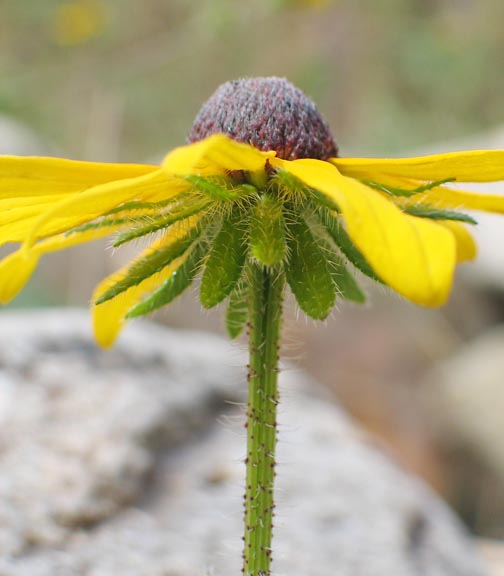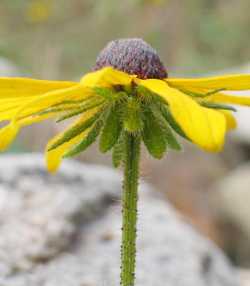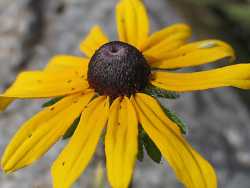Annuals, biennials, or perennials, to 100 cm (taprooted or roots fibrous). Stems hispid to hirsute (hairs spreading, 1+ mm). Leaves: blades elliptic, lanceolate, or ovate (not lobed), bases attenuate to cuneate, margins entire or serrate, apices acute, faces hispid to hirsute; basal petiolate, blades 8-30 × 0.5-7 cm; cauline petiolate or sessile, blades (sometimes pandurate) 3-20 × 0.4-4 cm. Heads borne singly or (2-5) in loose, corymbiform arrays. Phyllaries to 3 cm (faces hispid to hirsute). Receptacles hemispheric to ovoid; paleae 4-6 mm, apices acute, often attenuate, abaxial tips hirsute to hispid. Ray florets 8-16; laminae (usually uniformly yellow to yellow-orange or with a basal maroon splotch, sometimes mostly maroon) elliptic to oblong or oblanceolate, 15-45 × 5-10 mm, abaxially hispid to hirsute. Discs 12-22 × 10-20 mm. Disc florets 250-500+; corollas proximally yellowish green, distally brown-purple, 3-4.2 mm; style branches ca. 1.5 mm, apices subulate. Cypselae 1.5-2.7 mm; pappi 0.
Some strains of Rudbeckia hirta are cultivated and/or used in seed mixes for 're-naturalization' and erosion control.
Biennial or short-lived perennial 3-10 dm, ±hispid or hirsute throughout; lvs variable, the lower mostly oblanceolate to elliptic and long-petiolate, the others lance-linear to oblong or ovate, mostly sessile; heads mostly long-pedunculate, the hemispheric or ovoid disk 12-20 mm wide, dark purple or brown (yellow); invol bracts copiously hirsute or hispid, sometimes much elongate; rays 8-21, orange or orange-yellow, sometimes darker or marked with purple at base, 2-4 cm; receptacular bracts acute, ±hispid or hispidulous near the tip; style-appendages elongate, subulate; pappus none; 2n=38. Various habitats; Nf. to Fla., w. to B.C. and Mex. June-Oct. Var. hirta occurs mostly in relatively undisturbed habitats in the mts. from Pa. to Ga. and Ala., and sparingly n. to Me. and w. to Ill.; it has coarsely toothed lvs, the basal ones with the blade 2.5-7 cm wide and about twice as long, the cauline ones lance-ovate to ovate or pandurate. Var. pulcherrima Farw. (R. serotina) is widespread especially in disturbed habitats; it has entire or finely toothed lvs, the basal ones with lanceolate or oblanceolate blade 1-2.5(-5) cm wide and (3-)4-5 times as long, the cauline ones spatulate or oblanceolate to broadly linear.
Gleason, Henry A. & Cronquist, Arthur J. 1991. Manual of vascular plants of northeastern United States and adjacent Canada. lxxv + 910 pp.
©The New York Botanical Garden. All rights reserved. Used by permission.










